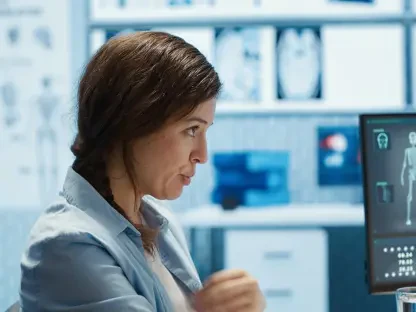In an era where digital tools dominate healthcare delivery, the risks associated with medication errors through electronic systems have become a pressing concern for providers and patients alike, highlighting the urgent need for robust safety measures. Imagine a scenario where a simple typo in an electronic health record (EHR) leads to a patient receiving the wrong dosage of a critical medication, resulting in severe consequences. Such incidents, though preventable, underscore the importance of clear and accurate digital communication of medication information. The Institute for Safe Medication Practices (ISMP), an ECRI company, has recently revised its guidelines to address these very challenges, focusing on the evolving landscape of health information technology (HIT). These updates aim to standardize practices across platforms like e-prescribing systems and pharmacy information systems, ensuring clarity and reducing errors in an increasingly complex environment.
Evolving Standards for Digital Medication Communication
Strengthening Clarity in Drug Information Display
The revised guidelines from ISMP place a significant emphasis on the safe and clear presentation of drug information within electronic systems. A key focus is the proper display of drug names, advocating for the use of both generic and brand names alongside techniques like tall man lettering to distinguish look-alike medications. This approach helps prevent mix-ups that could lead to harmful errors during prescribing or dispensing. Additionally, the guidelines call for comprehensive medication orders, ensuring that vital details such as dose, route, frequency, and indication are explicitly stated. By discouraging ambiguous shortcuts or abbreviations, the recommendations aim to eliminate misinterpretation at critical junctures. These measures collectively work toward creating a safer digital interface where healthcare professionals can make informed decisions without the risk of confusion.
Beyond the specifics of drug naming and order details, ISMP underscores the importance of intuitive search and selection tools within electronic platforms. Systems like EHRs and pharmacy databases must be designed to minimize selection errors by presenting complete medication profiles, including dosage forms and administration routes. This functionality ensures that users are not left guessing or relying on incomplete data, which often leads to mistakes. The integration of such features reflects a broader understanding that technology must be user-friendly and error-resistant to truly enhance patient safety. As healthcare continues to digitize, these standards provide a blueprint for developers and providers to prioritize accuracy over convenience, safeguarding outcomes in both inpatient and outpatient settings.
Integrating Patient-Specific Safety Data
Another cornerstone of the updated guidelines is the seamless incorporation of patient-specific safety information across digital platforms. Critical data points, such as allergy details, unique patient identifiers, and clinical warnings, must be prominently displayed to guide healthcare providers during medication-related tasks. This consistent visibility helps prevent adverse reactions by ensuring that no vital information is overlooked amidst the complexity of electronic records. Whether in prescribing, dispensing, or administering medications, having immediate access to such details fosters a protective barrier against errors that could jeopardize patient health. ISMP’s focus on this integration highlights the need for systems to prioritize individual patient contexts over generalized data.
Equally important is the standardization of how this information is presented across various HIT systems. Discrepancies in display formats or accessibility can create confusion among users who rely on multiple platforms daily. The guidelines advocate for a unified approach, ensuring that safety data remains consistent whether accessed through an EHR, a smart infusion pump, or a pharmacy system. This harmonization not only reduces the cognitive load on healthcare professionals but also minimizes the likelihood of oversight during high-pressure situations. By addressing these nuances, ISMP’s recommendations pave the way for a more cohesive digital ecosystem where patient safety is embedded into every interaction with technology.
Broader Impacts and Initiatives in Medication Safety
Adapting to Rapid Technological Advancements
The rapid evolution of HIT systems has transformed how medications are managed in modern healthcare, necessitating continuous updates to safety protocols. As highlighted by ISMP’s leadership, technologies like EHRs and e-prescribing platforms have become indispensable in both inpatient and outpatient care, yet they introduce unique risks that must be mitigated. The updated guidelines reflect a proactive stance, adapting to emerging challenges by setting clear standards for electronic communication. This adaptability ensures that as new tools and systems are developed, safety remains at the forefront, preventing potential errors before they occur. The consensus within the field is that without such forward-thinking measures, the benefits of digital innovation could be overshadowed by preventable harm.
Moreover, the broader trend of technological integration in healthcare calls for ongoing collaboration between developers, providers, and safety organizations. ISMP’s efforts exemplify this by not only updating guidelines but also fostering dialogue on how technology can be harnessed responsibly. The focus extends beyond immediate fixes to cultivating a culture of vigilance where every advancement is scrutinized for its impact on patient outcomes. This holistic perspective acknowledges that while technology offers efficiency, it must be paired with rigorous safeguards to truly serve its purpose. As digital tools continue to evolve, such guidelines will remain essential in balancing innovation with accountability.
Systemic Efforts to Bolster Safety Practices
In addition to guideline revisions, ISMP has spearheaded several systemic initiatives to enhance medication safety on a larger scale. A notable example is the launch of a state-mandated medication error reporting program for community pharmacies in California, marking a pioneering step in nationwide efforts. Established through legislative action, this program mandates confidential reporting of errors that reach patients, aiming to identify patterns and prevent recurrence. Such initiatives underscore the importance of transparency in addressing systemic issues, providing valuable data to refine practices across the healthcare spectrum. This structured approach complements digital guidelines by tackling errors at their root.
Furthering this mission, ISMP has also partnered with institutions like Ochsner Children’s Hospital to create fellowships focused on medication safety education for pharmacists. These educational efforts aim to equip professionals with the knowledge and skills needed to navigate complex digital systems safely. By investing in training, the organization addresses the human element of technology use, recognizing that even the best systems require competent users to function effectively. Together, these programs reflect a multifaceted strategy that combines policy, education, and technology to create a safer healthcare environment. Looking back, these steps demonstrate a commitment to not just react to challenges but to anticipate and shape a future where medication safety is paramount.









